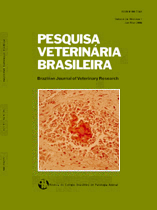 |
|
|
|
Year 2013 - Volume 33, Number 3
|

|
Experimental poisoning by Simarouba versicolor (Simaroubaceae) in sheep and induced resistance to consumption of the plant, 33(3):299-304
|
ABSTRACT.- Santos A.C., Faccin T.C., Carvalho N.M., Leal P.V., Pott A. & Lemos R.A.A. 2013. [Experimental poisoning by Simarouba versicolor (Simaroubaceae) in sheep and induced resistance to consumption of the plant.] Intoxicação experimental por Simarouba versicolor (Simaroubaceae) em ovinos e indução de resistência ao consumo da planta. Pesquisa Veterinária Brasileira 33(3):299-304. Faculdade de Medicina Veterinária e Zootecnia, Universidade Federal de Mato Grosso do Sul, Av. Senador Filinto Müller 2443, Campo Grande, MS 79074-460, Brazil. E-mail: ricardo.lemos@ufms.br
Simarouba versicolor St. Hil. is a semideciduous tree belonging to the Simaroubaceae family. An outbreak of poisoning in cattle by shoots of S. versicolor present in the pasture in Mato Grosso do Sul and experimental reproduction of the poisoning was described. This study aimed to verify experimentally whether sheep could be used as a clinical-pathological model in the study of the poisoning caused by S. versicolor, to determine if there develops resistance induced by ingestion of small and repeated doses of the leaves, and if the plant keeps its toxicity when dried. Two experiments were conducted: Experiment 1 with green leaves or dried and powdered leave of S. versicolor, given in single doses of 5g/kg, 5g/kg and 3g/kg to three sheep (Sheep 1, 2 and 3 respectively). Experiment 2 was made with different daily doses of dried and powdered leaves of S. versicolor; to four sheep was given 1.5g/kg, 0.75g/kg, 0.6g/kg and 0.3g/kg, and the positive control (Sheep 4) received 3g/kg. The administration was suspended when the animals showed clinical signs of poisoning. After twelve days of recovery, the surviving sheep were challenged with the same daily dose given previously, to assess the development of resistance. Clinical signs observed in both experiments were characterized by anorexia, congested ocular mucosa, polydipsia, drooling, loose stools which evolved into fetid greenish watery diarrhea, lateral decumbency and death of Sheep 1 to 7. The main histological lesions observed were necrosis of lymphoid tissue (lymph nodes, spleen, Peyer’s patches) and necrotizing enteritis. With the results it can be concluded that sheep can be used as experimental model for the clinic-pathological aspects of poisoning by S. versicolor. The method used has not shown resistance to the daily consumption of the plant by the sheep, and the leaves kept their toxicity when dried. |
| |
|
|
| |
|
 |